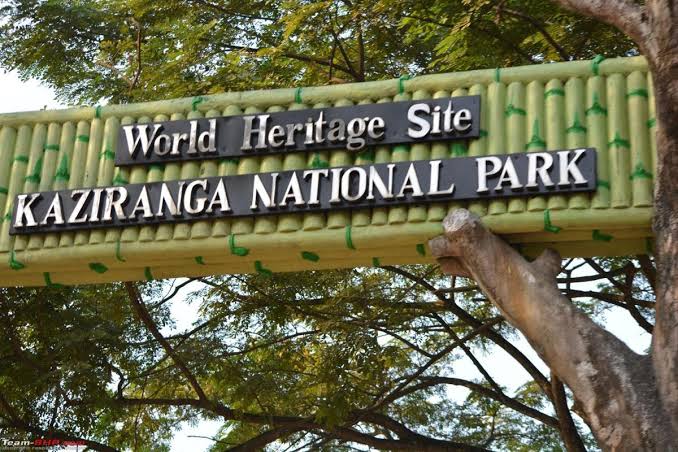
Kaziranga National park, on the southern banks of the Brahmaputra, offers splendid wildlife viewing and is the last remnant of a habitat once spread throughout the valley. The largest population of one –horned rhinoceros is here. Mainly Kaziranga is famous for its Big Five- The Asian Elephant, The Asiatic Wild Buffalo, The Swamp Deer, The Tiger, and The Great One-Horned Rhinoceros. The Kaziranga National Park has recorded the highest number of The Great Indian One-horned Rhinoceros because of great conservation success story behind it and the efforts of the authority and the local people must be appreciated, they make the conservation possible. It has also recorded a number of threatened wild animals and migratory birds. It has a rich variety of birds, both resident and migratory and the land can be described as a bird watcher’s delight. So, far more than 500 species of birds has been recorded in Kaziranga.It is to be kept in mind that, Kaziranga is the only place in the entire Northeast which has the highest ecological density of the tiger and the last surviving population of the Swamp Deer.
Milestones in Conservation 1905 – Declared Proposed Reserve Forest
1908 – Declared Reserve Forest with an area of 57,273.6 acres
1916 – Declared Game Sanctuary
1926 – Hunting banned and declared a Forest Reserve (232 sq. kms)
1938 – Opened to Visitors
1950 – Declared a Wild Life Sanctuary
1974 – Declared a National Park
1985 – UNESCO declares Kaziranga National Park a World Heritage
2005 – Kaziranga National Park celebrates its centenary (1905 – 2005) 2006 – Proposed as a Tiger Reserve. 2008- Declared as a Tiger Reserve.
Climate in Kaziranga National Park.
KAZIRANGA NATIONAL PARK GEOGRAPHICAL DETAILS Area – 860 sq. km (Addition made and stands to 1002 sq.kms.)
Latitude – 26o 30′ N – 26o 45′ N
Longitude – 93o 05′ E – 93o 40′ E
Altitude – 40-80 meters above sea level
Rainfall – Mean annual rainfall is about 2220 mm. Temperatures- 32oC to 5oC.
Best Time to Visit.
The three primary seasons in Kaziranga are summer, monsoon and winter.The winters are mild and dry while the monsoon, which lasts from June to September, is humid and tropical.However, the best season to visit would be November to April, when one can find the wide range of flora and fauna in abundance.
Where to Stay/ What to See.
Kaziranga has developed a lot over the last few years. It is perhaps the only place in the entire Northeast region where the hospitality and service industry has flourished so much over the years. The government lodges, guest houses, number of private hotels, resorts and lodges are available which are well equipped and range from low budget to luxury.
Kaziranga is a place where one can lose oneself to the wonders of nature. The lush green surroundings, the abundant flora and fauna or even the ambience, anyone would be awestruck by this magnificent creation of God. There cannot be a better place than Kaziranga, if anyone wishes to see the animals in natural habitat. The jungle can be explored by the safaris in a jeep, elephant and boat. There are mainly two modes of transport in the park – elephant and jeeps. Recently boat ride is also added to its beauty. Walking inside the park is not allowed.
As the National Park covers an area of more than 1000 sq.kms, it has been segregated as The Central Range for mammals, water bodies and birds, The Western Range for mammals, birds and water bodies, The Eastern Range- the birds paradise and the dolphins, The Burapahar range (trekking mainly for birds and gibbons), and T he Panbari Reserve Forest (trekking mainly for birds and gibbons).
An avid nature lover cannot help but fall in love with the beauty of this place and there is no doubt that everyone would definitely want to witness Kaziranga, the nature’s bounty.
How to Reach Kaziranga National Park.
Kaziranga National Park can be approached from either side via national highway 37. This highway leads to Guwahati (220 kms) in the west and to Jorhat (90 kms) in the east. It is well connected by buses and taxis from both these towns. Both these cities are the closest airports.
If one is coming by rail Jorhat (90 km ), Furkating ( 75 km ) and Guwahati ( 200 km ) are the nearest stations.From such places one can hire a taxi to reach the park.
By Air, The nearest Airport is at Rowriah in Jorhat which is 97 kms away from Kaziranga.There is also a International Airport at Guwahati which is about 250 kms away.
Hotels in Kaziranga


